May 8th, 2014 §
The day I buy the vegetables that will be the year’s summer garden is always a happy day. The first smell of crushed tomato leaves jolts awake some deeply-buried, winter-weary brain synapses and floods my entire body with relief and joy. When the tomatoes come out, winter’s really over. We made it through another one.
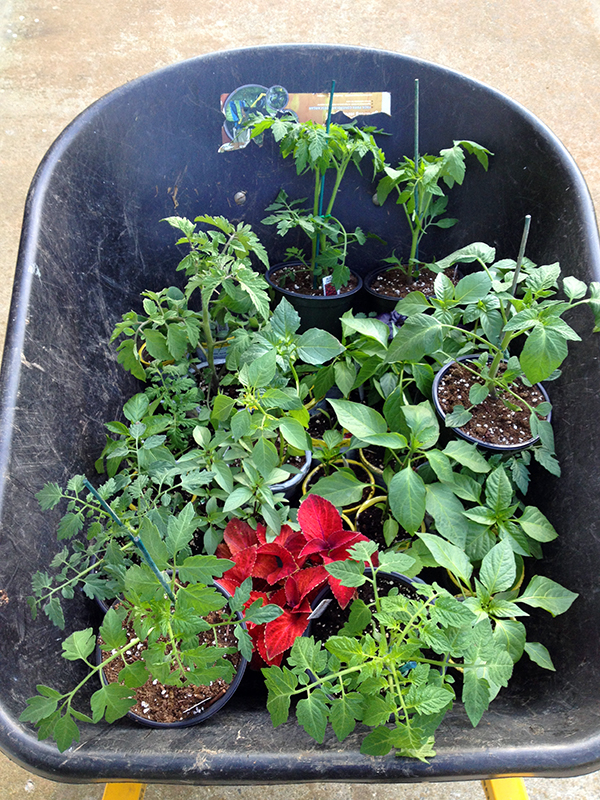
It’s hard to imagine it today when an entire garden’s worth of veg fits in the wheelbarrow, but in a couple of months these small plants will be pumping out enough produce to keep my family and me in good supply, with extra left over for freezing or friends.
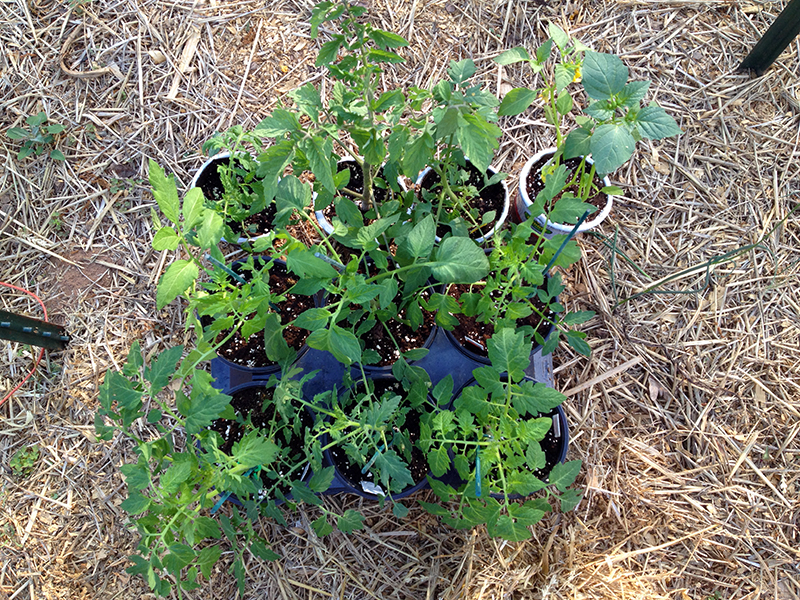
That is, of course, if I am lucky and smart in my battle against innumerable insects, diseases, and weather. Growing pesticide-free food, at least in central Virginia, is a nonstop intellectual challenge, a chess game of anticipation and reaction. It’s never easy, but I suppose that’s why I keep doing it.
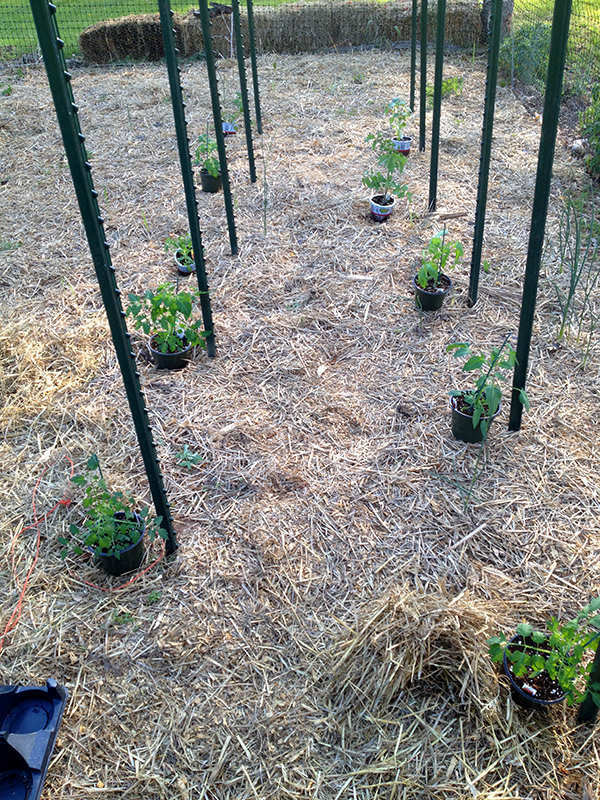
Let the games begin!
November 4th, 2013 §
Sunday morning dawned just a beautifully as Saturday, though it was cooler and substantially more windy. After lunch I headed outside to keep working at the vegetable garden cleanup. Unfortunately I had overdone it the day before and reactivated an old injury, a muscle spasm in my upper back next to my shoulder blade. In addition to being constantly uncomfortable, it makes turning my head to the right, such as when backing up the car, downright painful. Farming. Let me count the ways it hurts.
Regardless of any physical discomfort, the garden still needed more attention. First I dug out a couple dozen dahlia tubers for winter storage in the garage. I was amazed at the size of most of these tubers—just gigantic. Seeing this, I am suspicious that something caused this year’s dahlias to put their energy into making tubers instead of into flowers. More research on my theory to come.
I moved the dahlias’ labels, which are attached with twist-ties, from the wire support cages directly to the tubers to keep them properly labeled.
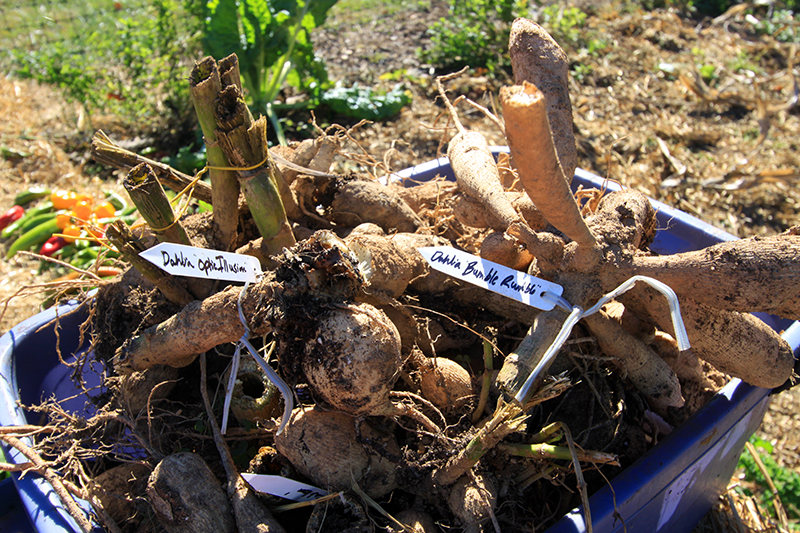
I stacked the custom-made cages and wired their ground pins to them for safekeeping. When I get around to it I will layer the tubers in boxes of peat to keep them from either drying out or rotting during winter. Last year I hung the tubers in mesh bags in the garage and lost some of them to drying out, so I will try a different technique this year.
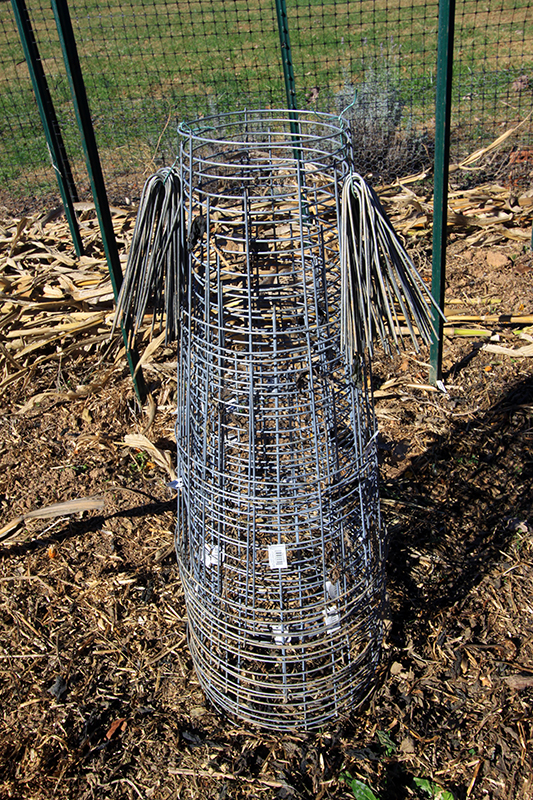
Then I had to figure out what to do with the Glass Gem corn stalks. I tried digging one stalk out, but the root ball that came with it was so massive and full of soil and beneficial worms that I realized I’d be transplanting most of my hard-won, improved garden soil directly into the woods if I chose that route. So I decided to chop each stalk off at the ground and hope that the root balls would just decompose and continue to feed the soil without the major disturbance of digging. We’ll see. I figured that come next spring, anything I’d want to plant in this area can be tucked amongst any stalks or root balls that may be left over.
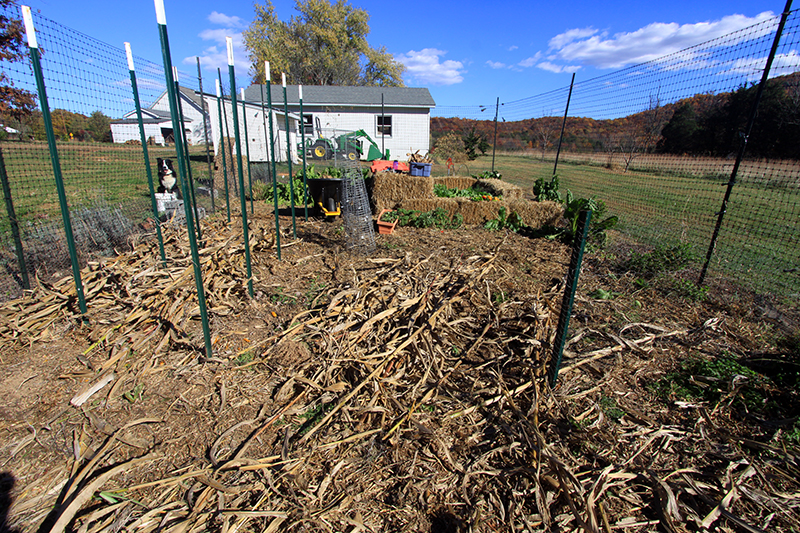
I am undecided about what to do with the stalks. I am heading toward leaving them on the ground over the garden. They will form a nice mulch layer to protect the soil below during winter, and if they’re still around in the spring they’ll be easy to pick up and remove to the compost pile. I plan on putting down a layer of compost then heavily mulching with straw anyway, so these corn stalks perform much the same function and help stretch the straw budget.
I still need to get the tomato stakes out, and then the next step involves shoveling compost into the garden and spreading straw. But as I was not in great compost-shoveling condition with this muscle knot, once I got the dahlias up and the corn down I quit garden cleanup and headed to town for an hour and half of vigorous vinyasa yoga in a warm studio, followed by liberal application of the gym’s hot tub jets to my back muscles.
November 3rd, 2013 §
Anytime after the first freeze of fall I am on the lookout for a few days of nice weather in order to put the garden to bed. This weekend was perfect for the job, with temperatures in the 60s, bright blue skies and sun streaming through the red, orange and yellow trees. Such glorious weather is, I suppose, a small consolation for what is one of my saddest markers of seasonal change. Take a look at this pathetic sight:
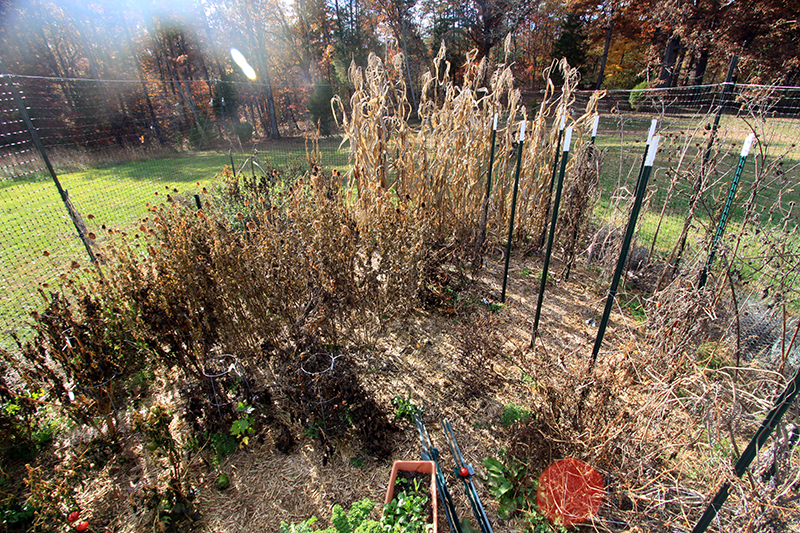
I started with the tomatoes, cutting them down from their stakes.
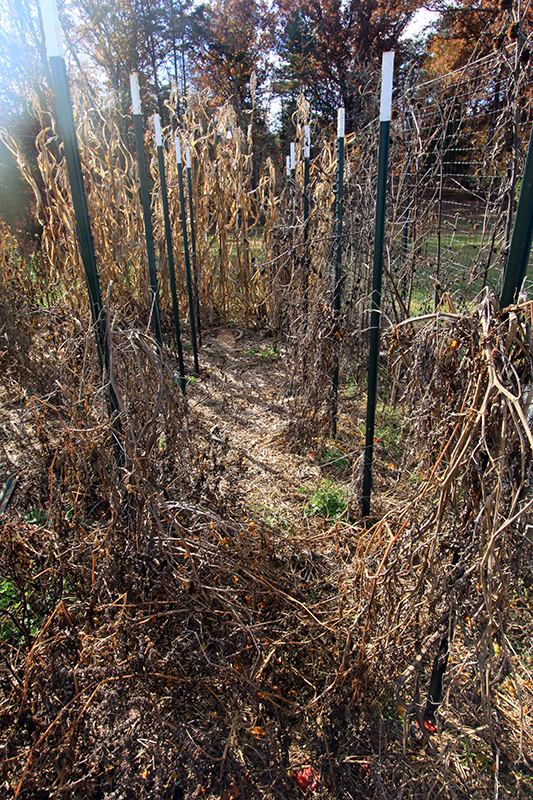
I always use cotton or jute twine to stake my tomatoes so that at the end of the season everything can go right in the compost, which beats having to pick pieces of plastic or wire out of the jumbled vines. I wasn’t too meticulous with picking up the dropped fruit as I plan on running the chickens in here during winter and they will appreciate the treats.
Then I moved on to ripping up the cosmos and zinnias, and as I did I saved seed heads from varieties that did particularly well. I plan to scatter these seeds over some bare spots in hope of starting a wildflower patch.

Then I cut the hyacinth bean vines off of the deer fence. A tedious job, indeed, to avoid cutting the plastic fence. Next year I will sow my hyacinth bean up the sides of the metal chicken run. Finally I pulled the frozen peppers out. I was annoyed at myself to find that there were so many peppers that I hadn’t harvested before it was too late. This is what happens when the first frost happens when the farmer is out of town for a couple of days!

Then I took a break from the vegetable garden to walk through the pastures, cutting out the prickly shrubs that are the first woody plants to initiate reforestation of cleared areas. It took several big tractor bucket loads to get everything to the compost and brush piles in the woods.
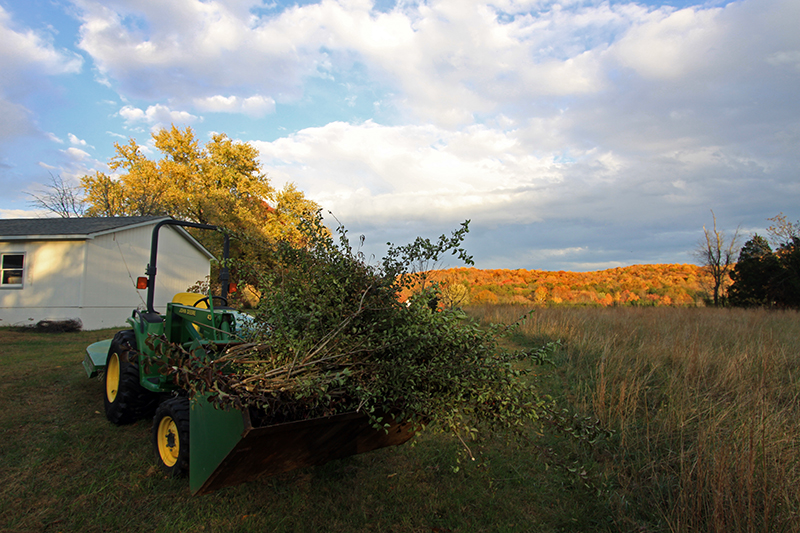
By then the sun was setting and I had been working outside for more than seven hours in a row. So when the chickens headed into roost, I did the same, straight for a hot epsom salt bath. Up next: day two of vegetable garden cleanup.
June 13th, 2013 §
I know I am way overdue with a vegetable garden update. In fact, I haven’t even posted much of anything about the veg garden this whole spring, even though I started working in there in March. The ensuing three months were taken up with gardening, not writing about gardening, so that means we will just jump right into a lush summer garden and skip all the photos of bare spring dirt.
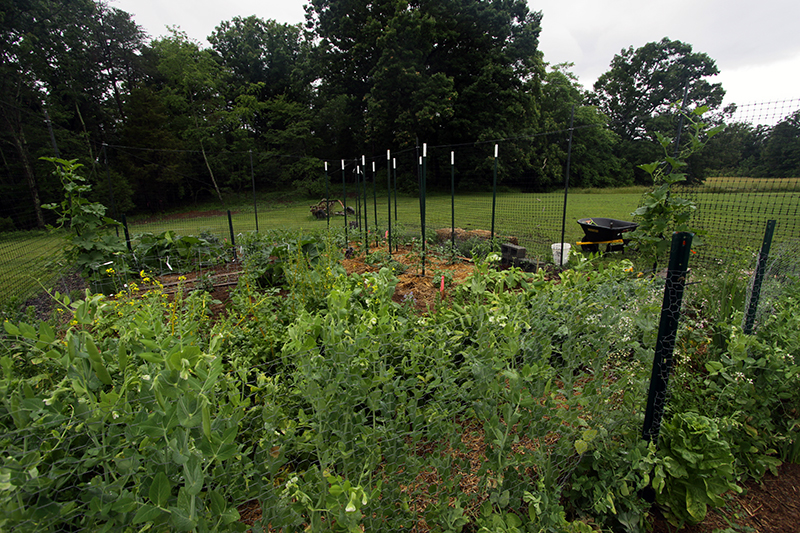
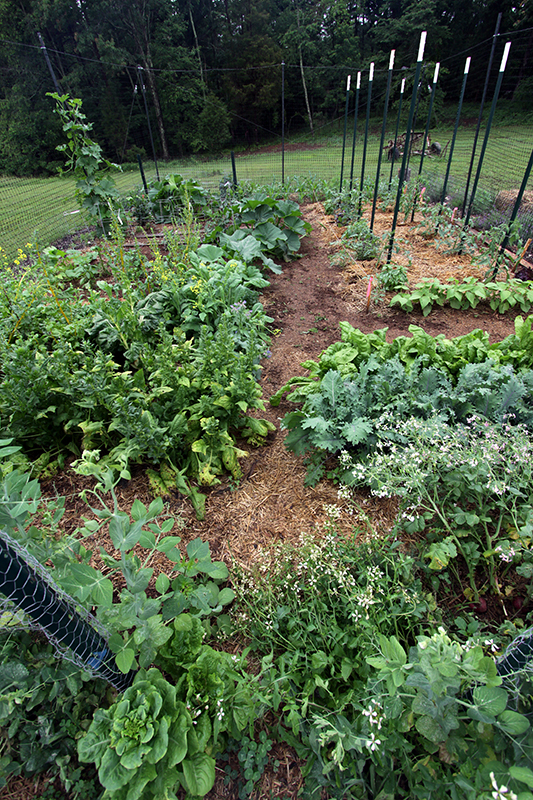
Starting in the foreground of the shot above, I have various lettuces and flowering arugula growing around the sugar snap pea. supports. Then, up the right side of the path are a row of zinnias, the peas, flowering radishes, Red Russian kale, Lucullus Swiss Chard, some dill, and the entry path. Then come some Dragon’s Tongue beans, then my patch of 11 tomatoes underplanted with various basils, a row of mixed wax, green and purple beans, and finally my Glass Gem corn. Up along the fence on the right side are sunflower and cosmos seedlings, and tucked here and there are tomotillos, hyacinth beans, poppies, and a volunteer squash.
Up the left side of the path are, out of view of this photo, sweet peas at the fence, Victoria rhubarb, another row of zinnias, more sweet peast, radishes, then overwintered spinach that’s about to be ripped out and replanted, cilantro, parsley, borage, thyme, a row of red Swiss Chard, overwintered bok choy and yellow chard, blueberries, strawberries, then a row of mustard, followed by rows of arugula and mache. Then some rogue ruffled kale seedlings, and about eight pepper plants. After that we get into the dahlia forest, interplanted with rows of zinnias, followed by the cucumber trellis, a squash, then even more dahlias, nasturtium seedlings, and my mint patch. Whew!
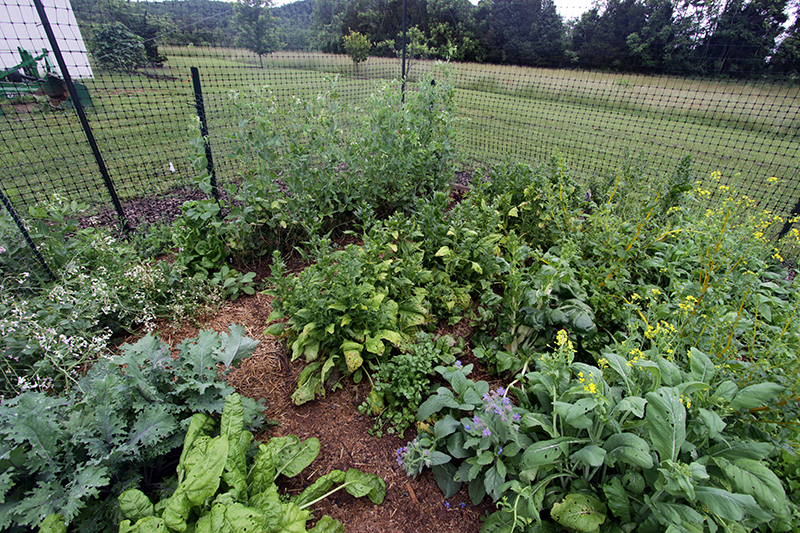
Let’s get closer. Up above are the various greens. The blue flowering plants are borage, and the mustard is blooming yellow. The radishes on the left have beutiful light pink flowers, and they’ve made “radish beans.”
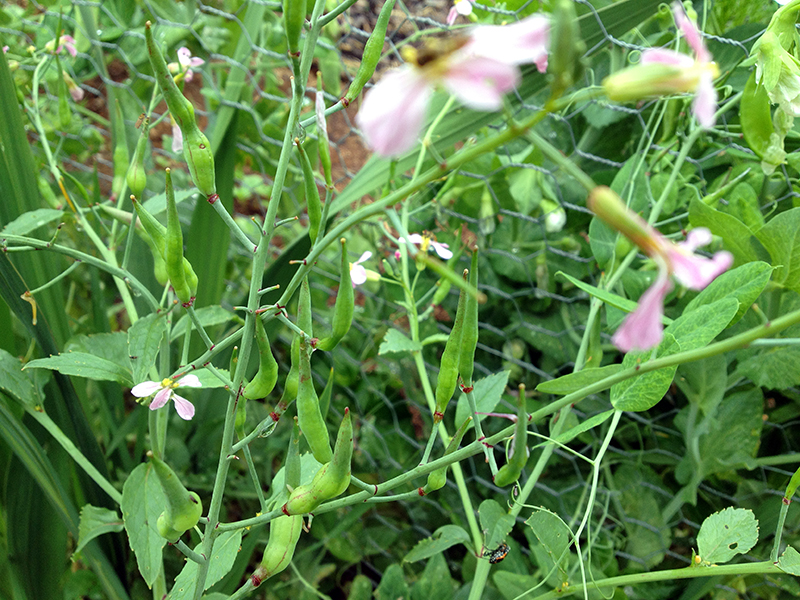
These radish seed pods are actually more delicious, to me, than the radishes. I am glad I let this crop go to seed and discovered a new treat.
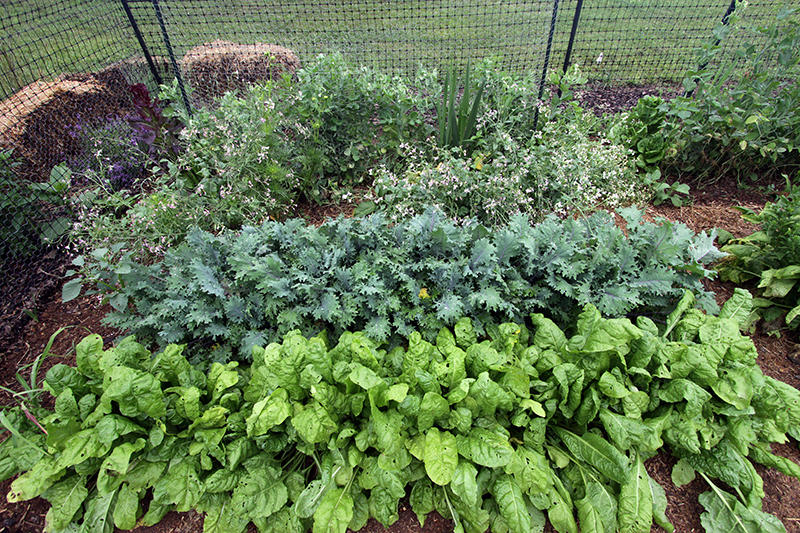
From the top: Peas, radishes, Red Russian Kale, Lucullus Swiss Chard
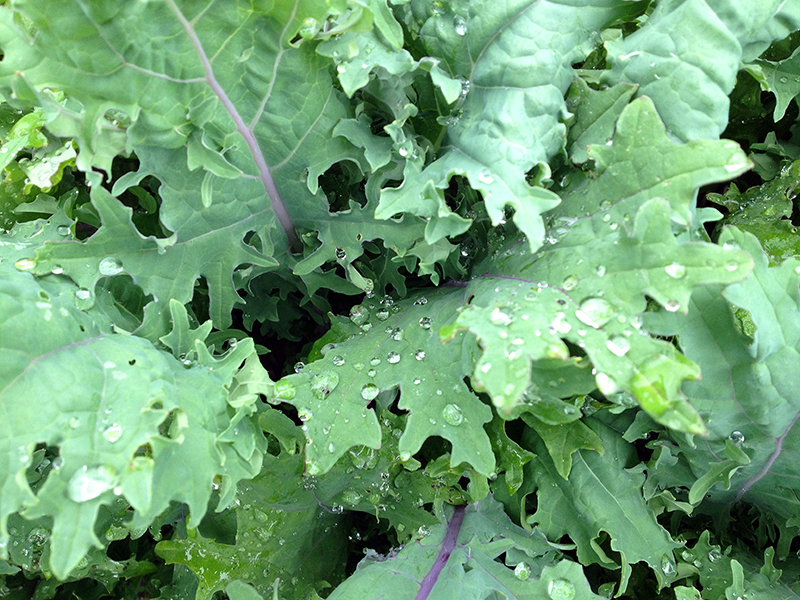
I find Red Russian kale to be one of the most beautiful plants I grow. Every thing about it, from the shape of the leaves to their color, pleases me. Last year my first seeding was preyed on by some sort of stink bug, but this year that bug has held off long enough for me to get a few leaves of my own. I suspect that it will only be a matter of time until the kale falls victim to some other bug, though. Such is the nature of (my) organic garden.
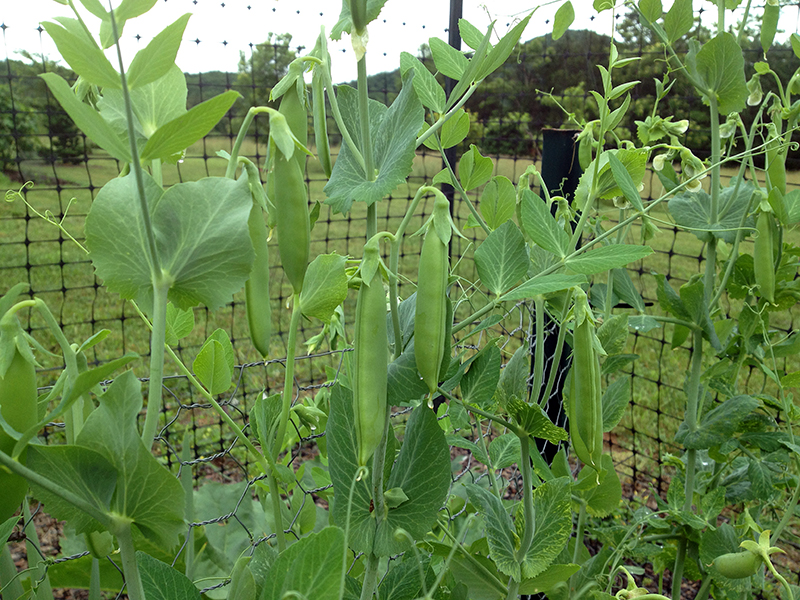
The snow peas are finally coming on. I am puzzled by snowpeas. The seed packets say to sow here in February or March. Well, February just seemed brutal to try to get something to grow, so I waited and sowed in March. It was a month before seedlings emerged. I didn’t get a great germination rate (they were old seeds), so I interplanted with new seedlings in April. These newer plants quickly caught up to the earlier-seeded siblings, just as of of my favorite gardening books said they would. I think this spring’s weather, which has alternated between highs in the mid-90s and being downright chilly, has the peas in a tizzy. I’ll be lucky to get a few delicious handfuls, and that will be it before I rip them out to plant something else. Central VA just doesn’t have the climate for growing these cool-season crops.
Up next: the rest of the garden…


















